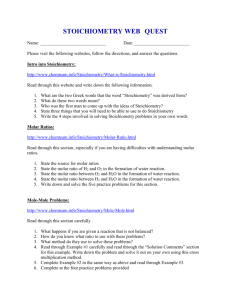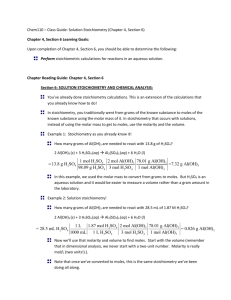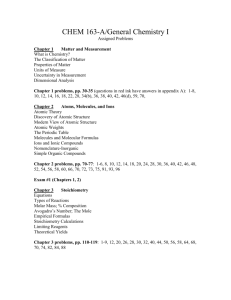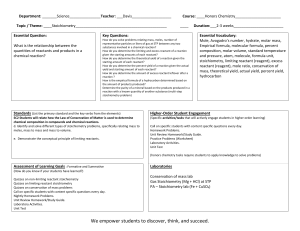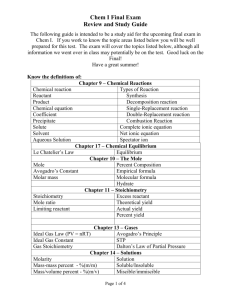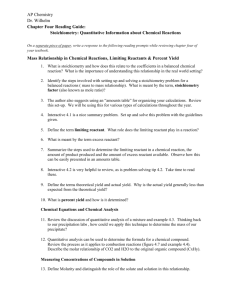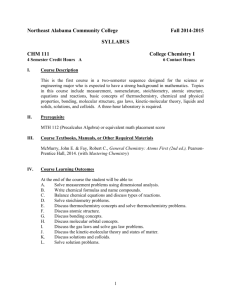Stoichiometry Skills Gateway Overview.
advertisement
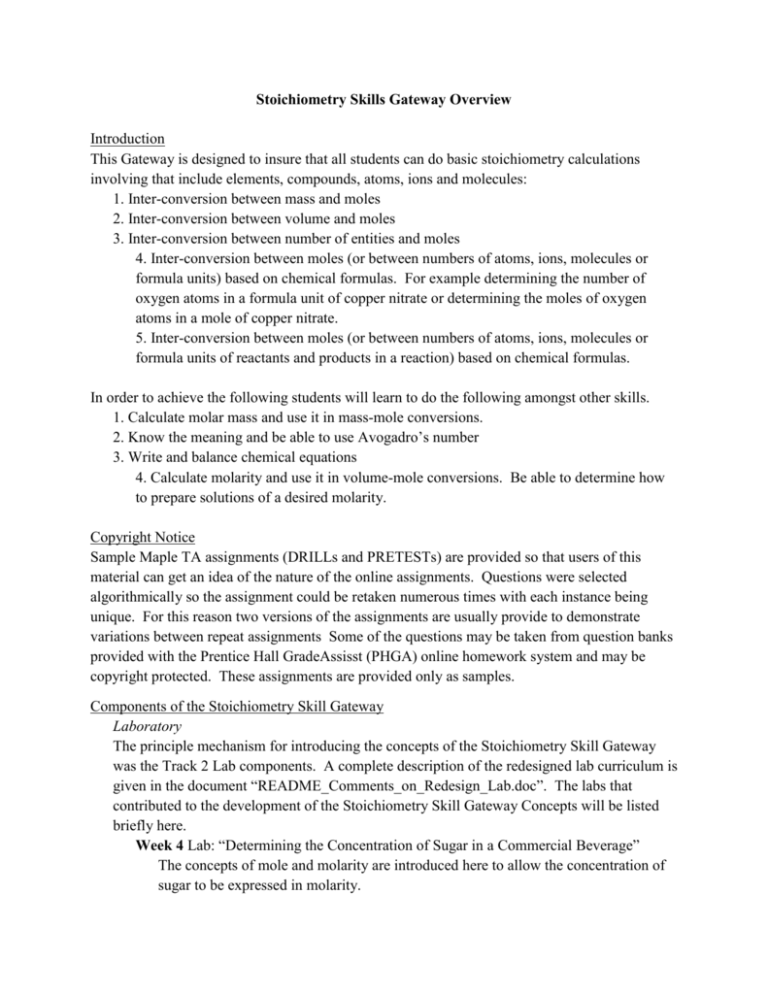
Stoichiometry Skills Gateway Overview Introduction This Gateway is designed to insure that all students can do basic stoichiometry calculations involving that include elements, compounds, atoms, ions and molecules: 1. Inter-conversion between mass and moles 2. Inter-conversion between volume and moles 3. Inter-conversion between number of entities and moles 4. Inter-conversion between moles (or between numbers of atoms, ions, molecules or formula units) based on chemical formulas. For example determining the number of oxygen atoms in a formula unit of copper nitrate or determining the moles of oxygen atoms in a mole of copper nitrate. 5. Inter-conversion between moles (or between numbers of atoms, ions, molecules or formula units of reactants and products in a reaction) based on chemical formulas. In order to achieve the following students will learn to do the following amongst other skills. 1. Calculate molar mass and use it in mass-mole conversions. 2. Know the meaning and be able to use Avogadro’s number 3. Write and balance chemical equations 4. Calculate molarity and use it in volume-mole conversions. Be able to determine how to prepare solutions of a desired molarity. Copyright Notice Sample Maple TA assignments (DRILLs and PRETESTs) are provided so that users of this material can get an idea of the nature of the online assignments. Questions were selected algorithmically so the assignment could be retaken numerous times with each instance being unique. For this reason two versions of the assignments are usually provide to demonstrate variations between repeat assignments Some of the questions may be taken from question banks provided with the Prentice Hall GradeAssisst (PHGA) online homework system and may be copyright protected. These assignments are provided only as samples. Components of the Stoichiometry Skill Gateway Laboratory The principle mechanism for introducing the concepts of the Stoichiometry Skill Gateway was the Track 2 Lab components. A complete description of the redesigned lab curriculum is given in the document “README_Comments_on_Redesign_Lab.doc”. The labs that contributed to the development of the Stoichiometry Skill Gateway Concepts will be listed briefly here. Week 4 Lab: “Determining the Concentration of Sugar in a Commercial Beverage” The concepts of mole and molarity are introduced here to allow the concentration of sugar to be expressed in molarity. Week 5 Lab: “Chemical Reactions I: Some Chemical Reactions Involving Oxygen” Students learn and practice writing and balancing chemical equations. Week 6 Lab: “Chemical Reactions II: Reactions of Ions in Solution” Students gain additional practice writing and balancing chemical equations. Week 7 Guided inquiry activity: “Counting Numbers of Atoms and Molecules – POGIL Activity” and “Molar Mass” lab. This lab provides thorough coverage of the mole concept, meaning and use of Avogadro’s number, molar mass and formula and reaction stoichiometry. Week 8 “Determining the Percent Composition of Potassium Chlorate in a Mixture” and “Titration of Vinegar” labs Students learn both gravimetric and solution stoichiometry. Module 1: “Moles and Molar Mass” Module Assessments DRILL - Stoichiometry I: atoms and elements Students practice conversions between grams, moles and numbers of atoms using the molar masses of elements. Two samples generated by the online homework system are provided. May contain copyrighted questions from PHGA online homework system. Version 1: “DRILL - Stoichiometry I: atoms and elements No 1.pdf” Version 2: “DRILL - Stoichiometry I: atoms and elements No 2.pdf” DRILL - Stoichiometry 2: Compounds and Formulas Students practice conversions between grams, moles and numbers of atoms, ions or molecules in compounds. Two samples generated by the online homework system are provided. May contain copyrighted questions from PHGA online homework system. Version 1: “DRILL - Stoichiometry 2: Compounds and Formulas No 1.pdf” Version 2: “DRILL - Stoichiometry 2: Compounds and Formulas No 2.pdf” Module 2: “Reaction and Solution Stoichiometry” Module Assessments Students practice stoichiometry problems involving chemical reactions both in terms of mass and molarity of reactants and products. The reaction arrow (→) appears as a in this printouts. This is a result of changing html standards in the evolving Maple TA software. These changes were an ongoing hindrance to advancement during the course redesign. DRILL Reaction Stoichiometry #1 Two samples generated by the online homework system are provided. May contain copyrighted questions from PHGA online homework system. Version 1: “DRILL Reaction Stoichiometry #1 No 1.pdf” Version 2: “DRILL Reaction Stoichiometry #1 No 2.pdf” DRILL Reaction Stoichiometry #2 Two samples generated by the online homework system are provided. May contain copyrighted questions from PHGA online homework system. Version 1: “DRILL Reaction Stoichiometry #2 No 1.pdf” Version 2: “DRILL Reaction Stoichiometry #2 No 2.pdf” Stoichiometry Gateway Exams Stoich Skill Gateway Exam Opt 1.doc Stoich Skill Gateway Exam Opt 2.doc Note on Stoichiometry Skills Gateway The online materials developed for the Stoichiometry Skills Gateway were limited by personnel restraints. A more thorough Stoichiometry Skills Gateway is possible. Even with this limitation, performance of students in the redesign section was similar to that of the control sections. This is significant, due to the fact that these concepts were principally introduced in the lab curriculum and reinforced with the gateway online homework, yielding similar results. This supports one of the hypotheses of this project in demonstrating that computation and stoichiometry can be developed independently in the lab curriculum.
